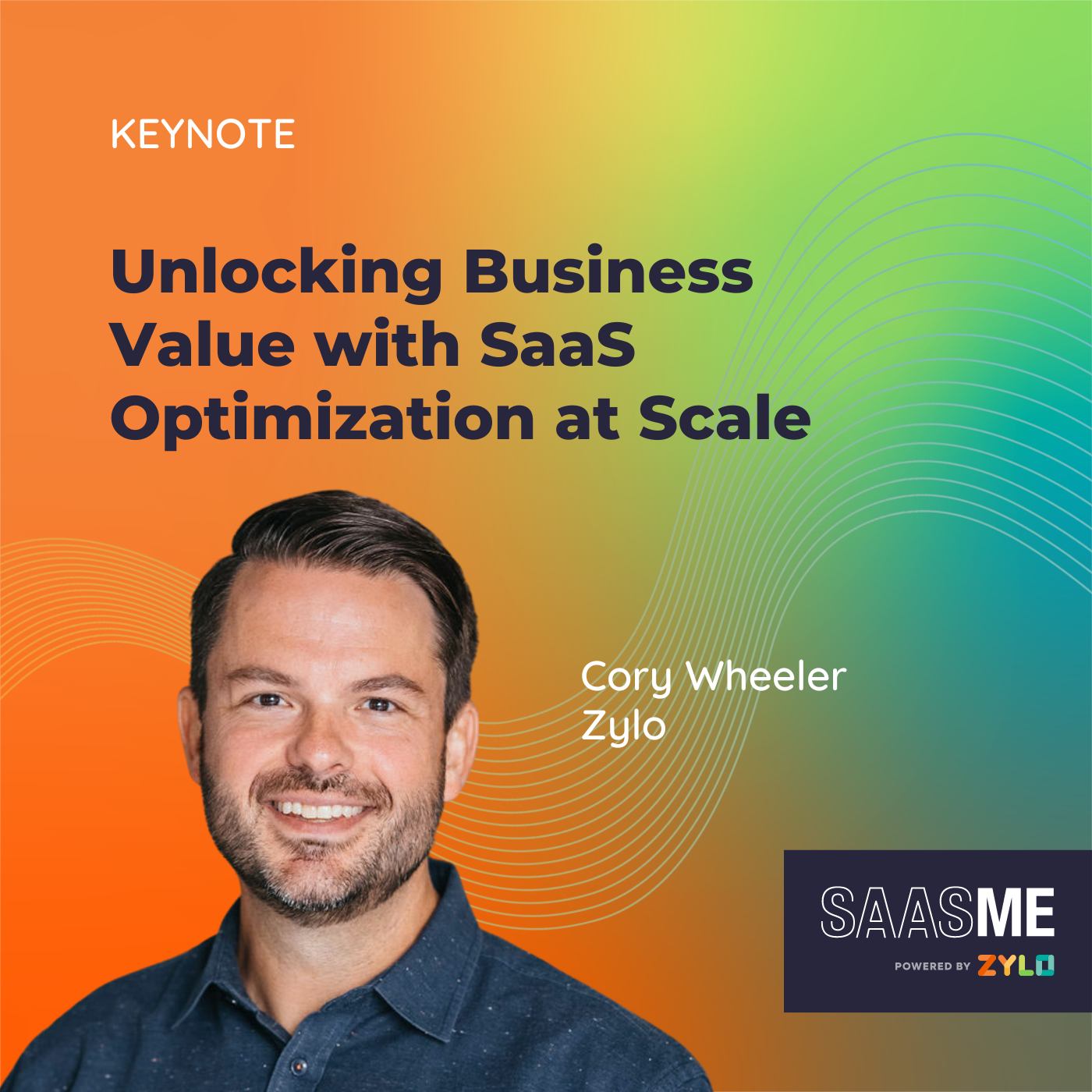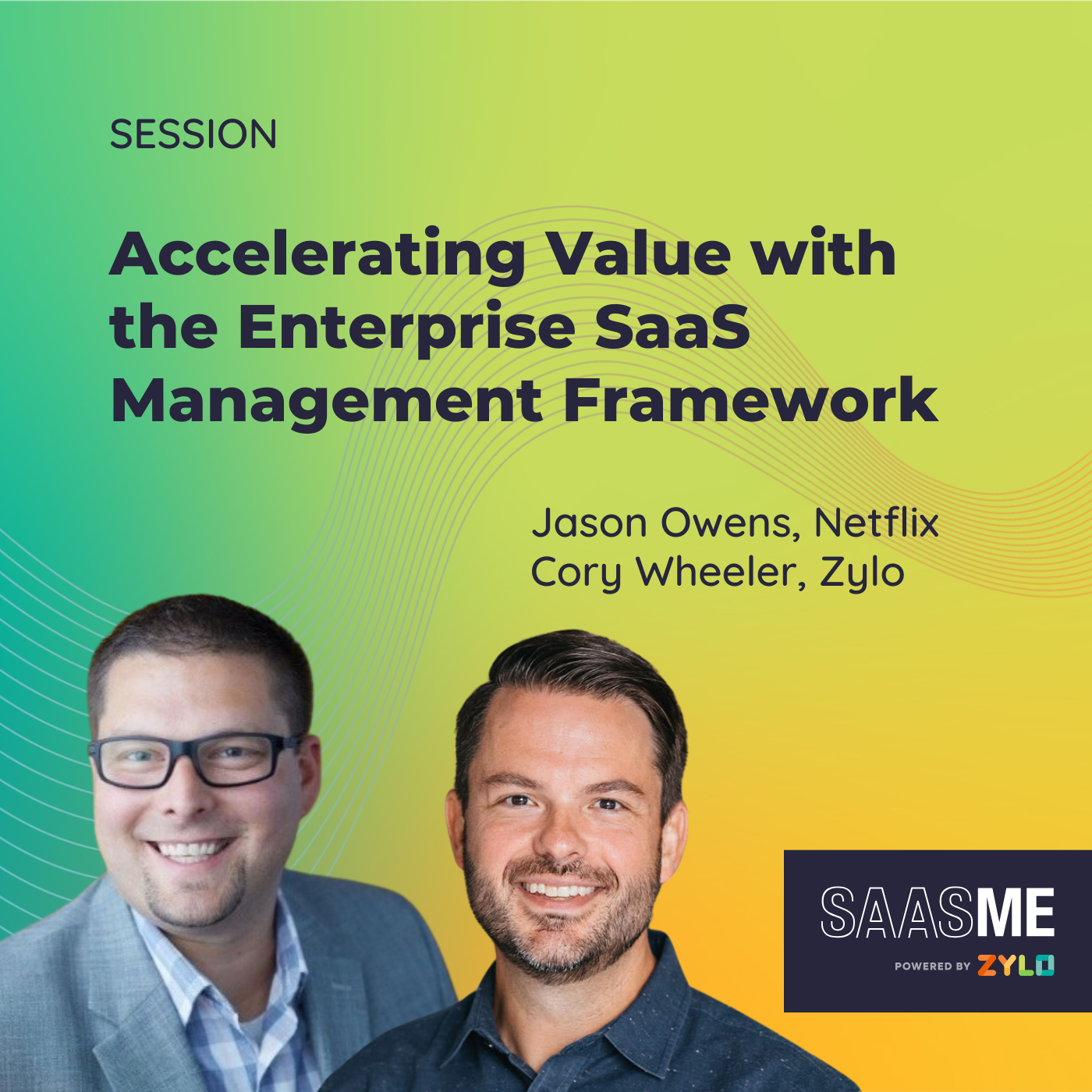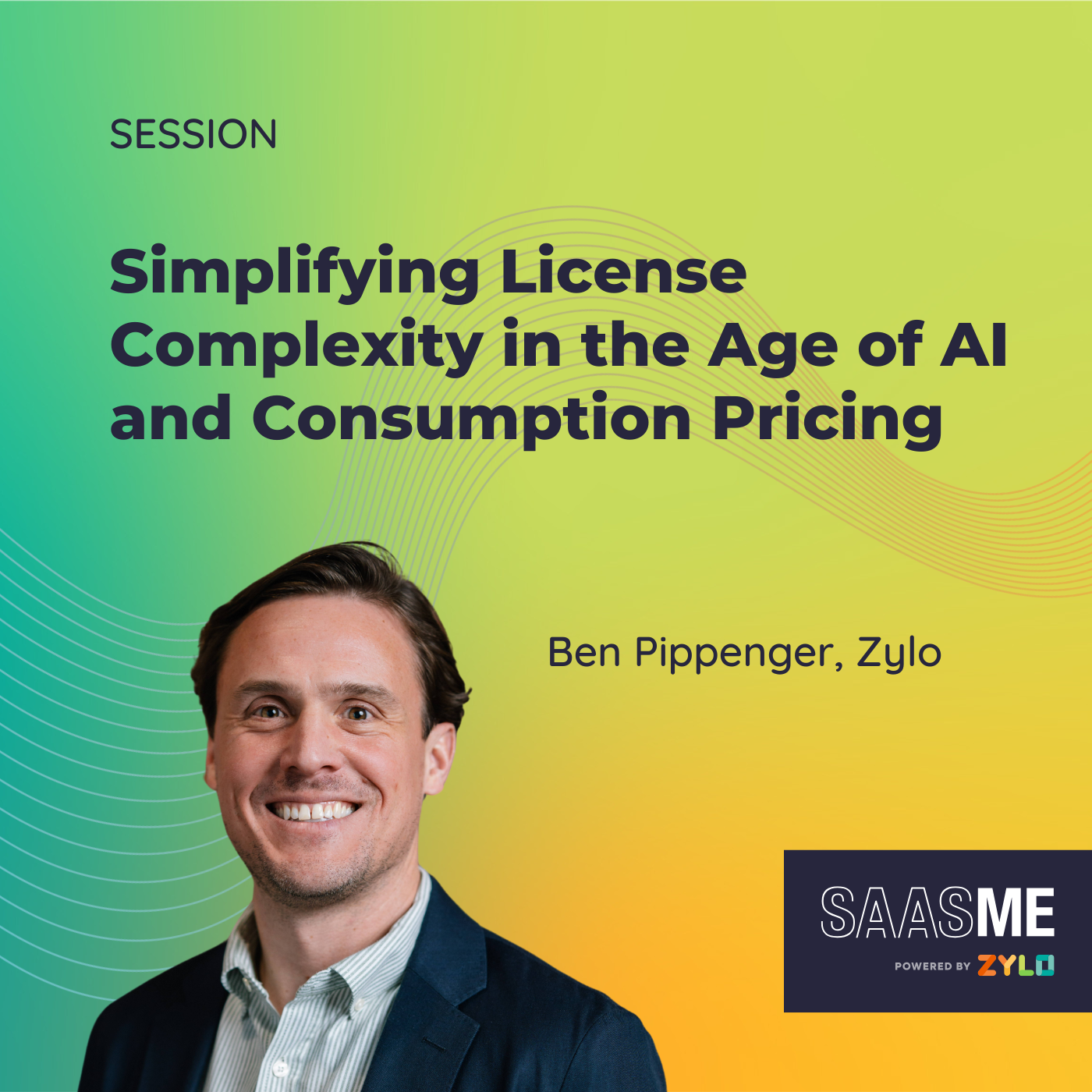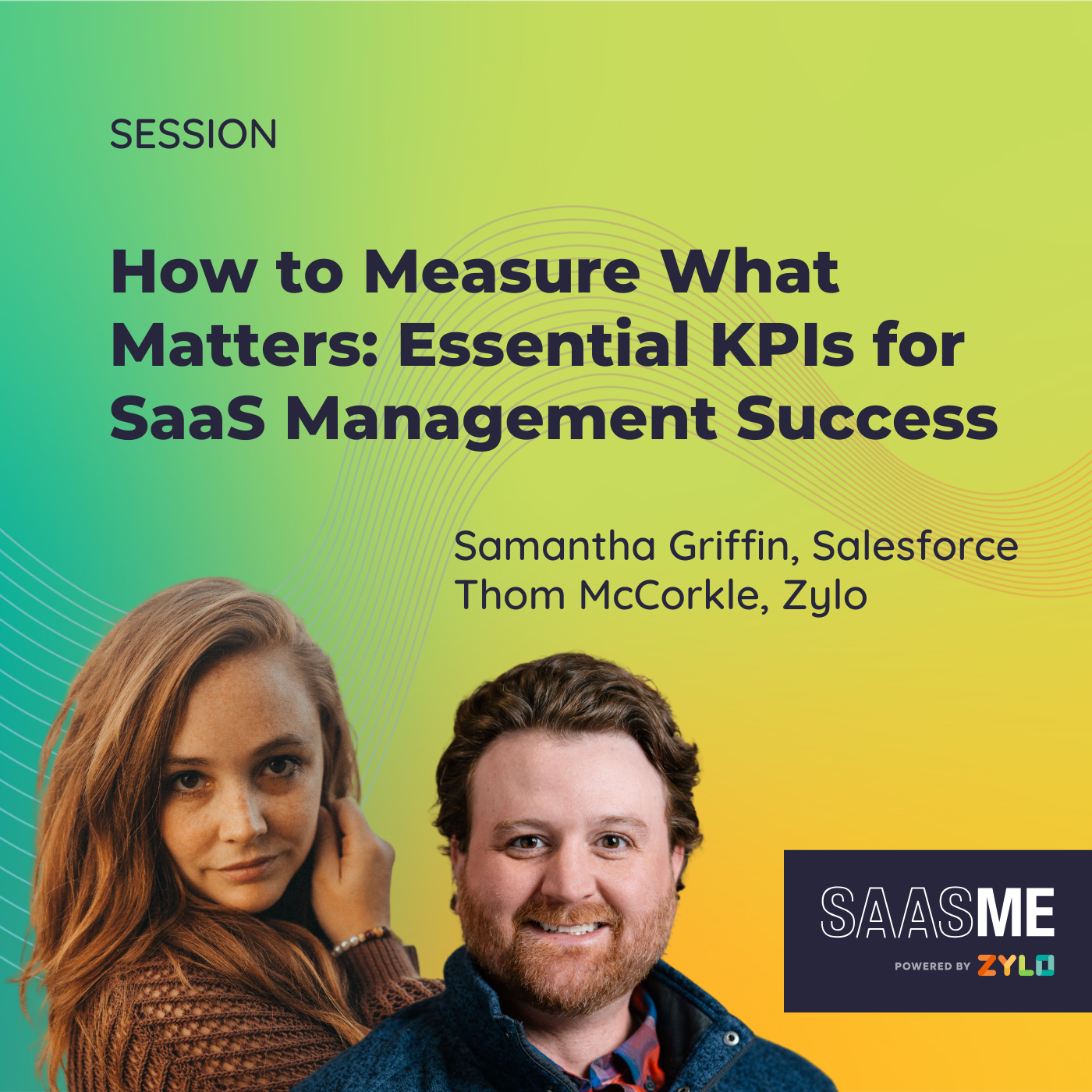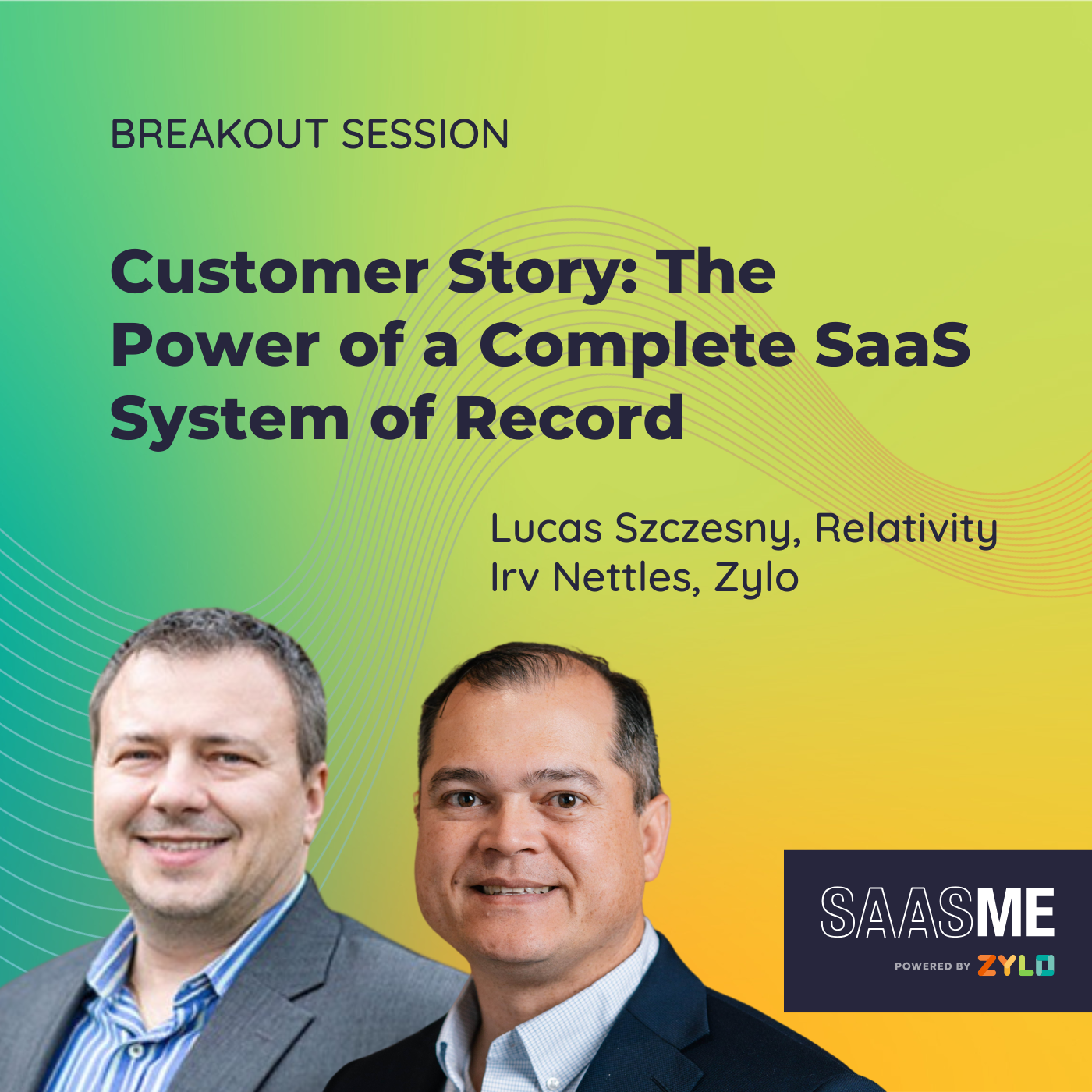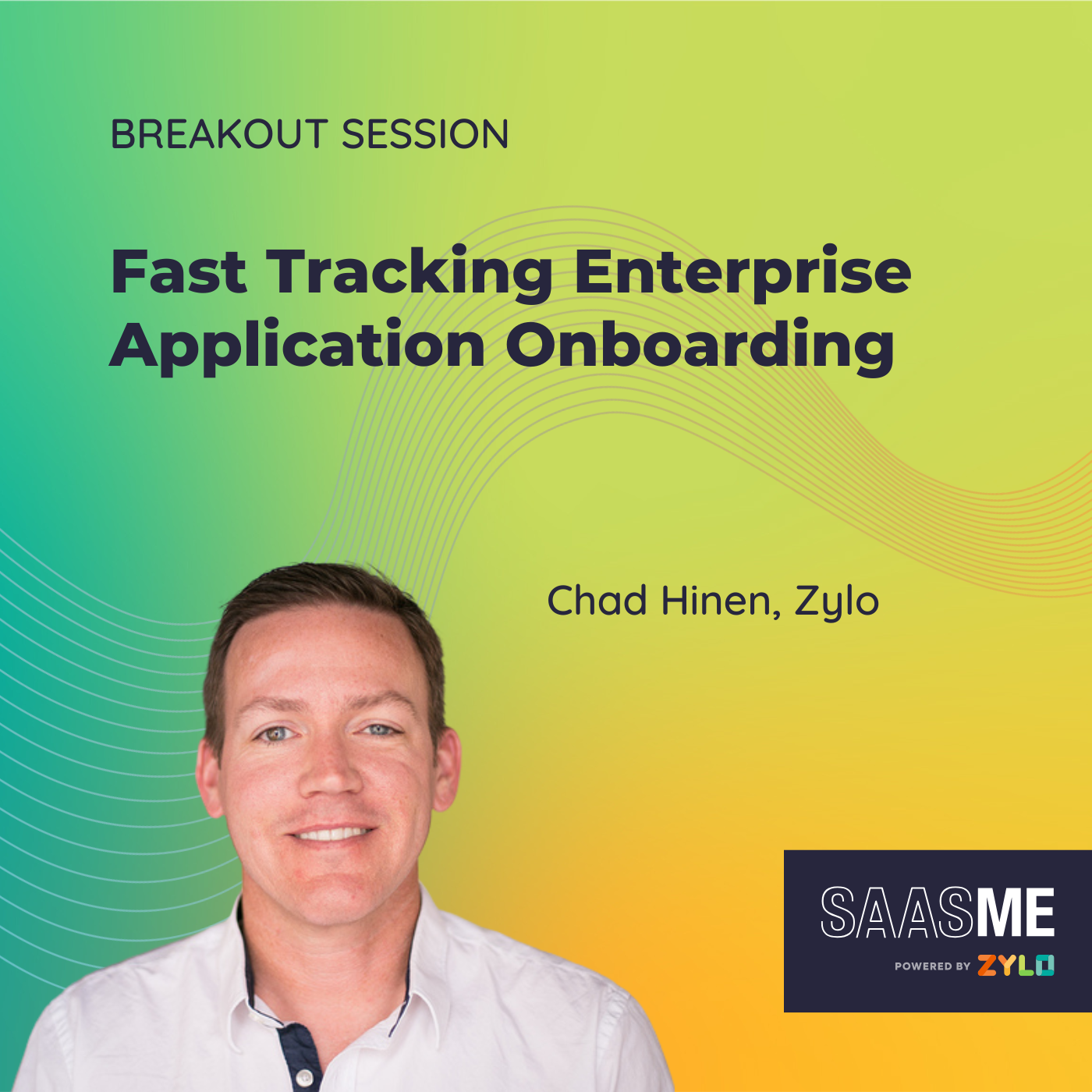Unlocking Business Value with SaaS Optimization at Scale
- 0.5
- 1
- 1.25
- 1.5
- 1.75
- 2
Cory Wheeler: Wow, we just heard from some phenomenal leaders, Jason, Casey and Sam. Thanks to Salesforce and Asurion. We heard them talk about what the role of IT in finance is, given the new era of responsible business growth. I'm Cory Wheeler, co- founder and chief customer officer here at Zylo. Thank you so much for joining us here at SaaSMe'23. What a day. Very excited to get into my content as well. What I want to talk about today is really unlocking business value. Of course, that's a very broad term, but what I want to do today is really define that term, define the framework around how you can articulate the opportunity inside your business and deliver those outcomes around SaaS management. Okay, well, let's say set the stage. I think we're all very familiar with this narrative on the screen right here. Three years ago, we came into the global pandemic, changes to the workplace. We're really moving everyone virtual. SaaS became the new workplace. It remained to be growth at all costs, really following what we saw from 2015 to 2020. However, the global pandemic really changed how people operated. Because SaaS became the new workplace, CIOs provision software, licenses were purchased on a one, two and three- year cycle because the fear of employees not being able to do their work was really the downside of that global pandemic. That became the new normal for most organizations. Well, now, welcome to the new new normal. And what we know about the new new normal is that the last year has been pretty tough. Out of that pandemic, we went straight into the economic headwinds, economic uncertainty in general. Many organizations now are entering 2023 and are in 2023 with initiatives that are reducing operating costs and the directive to accomplish more with less. We've seen rifts across the industry. Those cuts began in tech last year. Tech really took a lot of hits, still are, but what we've seen over the last quarter to two quarters is that non- tech industries are very much feeling the reduction in force, the operational cost directives from their investors, from their leadership teams. And now this is becoming a global and certainly a national directive for every organization. And that is fundamentals overgrowth, limiting burn, maximizing growth, the march to profitability. What we just heard previously around that era of responsible business growth. Where do CFOs look to affect that first? What's the bottom line directive? How do they drive quick change, sustainable change? Well, they look at those variable costs. What can they control right away? What can they make sure that they can control is controlled? Controlling the controllables, so to speak. Well, what we know about that is those variables begin with OpEx, operational expenses. Within that, what we very much know is SaaS is for many organizations, your second largest OpEx line item, right after headcount. Most organizations now are preserving headcount, making those tough decisions as an organization so they don't have to look at rifts, so they can manage more efficiently, do more with less. And SaaS is absolutely under the microscope. What do we know about SaaS? Well, we know that SaaS is today a total decentralized mess in most organizations. CIOs say, " Chaos." It's their first word when I speak with them about their experiences with SaaS within their business. SaaS is no longer managed centrally by a single team. It has become very much a team sport, where many different functions and capabilities within an organization come together to manage a sprawled and growing category within their business. At Zylo, every year, we release our SaaS Management Index report, the SMI. In 2023, we released this just a few months ago as well. What we know is that from an industry perspective, Gartner comes out very clearly and says it, SaaS will continue to grow. Of all the IT categories, SaaS will continue to expand in most organizations despite the economic headwinds. When we look at our Zylo customers, what we've seen is these are organizations that are prioritizing SaaS management, that are prioritizing OpEx reductions. What we've seen across our customer base is an overall reduction of 10% of spend, 4% of applications for those customers. Look at the numbers. The average application count inside our customers today extends from 170 applications, all the way up to 664 applications on average. You'll get to hear from Ash Rai from Adobe later on today. When they went live with Zylo, they had 2, 600 applications inside their business. Staggering. From a spend perspective, this is very material as well. Small companies spending around$ 8 million on software, large enterprises, 200 million plus per year. That OpEx is something that you can affect today. Variable costs are all a part of overall cost reduction strategies for most enterprises. SaaS is distributed. It will continue to be distributed. What does that mean? Well, that means that we know a few things. We know that number one, your SaaS portfolio today is full of waste. Some staggering metrics. 44% of all software licenses are wasted, are going unused in a typical 30- day window. Extend that out to 90 days, you're looking at around 25% of licenses going unused. When we began Zylo many years ago and we started pulling this data together, we had to spend a lot of time on this data. I didn't trust that it was accurate. I was blown away by that metric, that 56% of all licenses are truly being used on a category that has eight to 220 plus million in spend per year, depending on your size of an organization. Staggering. The average employee is using around$4, 000 worth of tooling for their job. 20% of your cost today are overspend. Negotiating more aggressive terms, prices, being able to aggregate this data together and being able to drive a better negotiation, removing licenses, looking at price points, looking at benchmarks. 20% is the conservative number for what organizations are just overspending today for the licenses they do have. So your SaaS portfolio's full of waste, but also it's creating business inefficiencies. I use business inefficiencies very much, it's a bit of alarming term, an alarming term, but I use that very much pretty intentionally. You know that waste is there. Lines of business are out buying software without the involvement of finance, procurement and IT. Your SaaS is literally being managed in spreadsheets today. We've worked at a lot of very large organizations that don't love to say it, but they've got many different teams managing their own spreadsheets throughout the organization. That's because 20 years ago, organizations had 25 applications, all in on these big packages and on- prem deployments, and those same companies now have 500 to 1,000 applications. There's rampant shadow IT, buying software on employee credit cards, literally swiping a credit card, agreeing to click wrap terms and immediately putting customer or business related data inside those applications. You've got overlaps. Companies using many different solutions that are overlapping and redundant. Maybe you're using 21 different project management tools and auto- renewals and even annual or three- year renewals are going missed. They're missed before they're negotiated. You miss your contractual commitment to notify a vendor of your intent to renew. That happens every single day. So you've got business inefficiencies, employees working in apps that are similar but that don't talk to each other. The number one problem I hear from CIOs is definitely the chaos and the inefficiency around around their employees. And so SaaS now is your greatest blind spot inside your business. The average customer underestimates the amount of SaaS they have by 2X. That's silo. It's your biggest opportunity. The massive shift from on- prem to the cloud has created this opportunity for centralized teams to manage this efficiency and chaos of a very distributed category. What does that mean? That means that provider relationships, vendor relationships are absolutely evolving given those economic headwinds and the fight for profitability of every organization. The old process of vendors and buyers really can't continue for solution providers that aren't delivering value each and every day. Now, providers, solution providers have to be shifting to a partnership, a true partnership, not just a partnership in words, but they've got to be able to deliver mutually defined value, documented mutually defined value that is measurable, that they're accountable to. You've got to demand that. You've got to demand that of your strategic partners, you've got to be able to get in front of that and change the narrative of your relationships with your vendors. But how do you even begin? Well, when you logically start to break this down and you think about software in your business, you probably think of these strategies. You know, I've got to track everything. I've got to find where it's at. I've got to be able to measure it once I find where it's at. I want to then be able to lower our overall costs. I want to better use our licenses. I want to get the value out of the software that we signed up for and I want to secure it. And these capabilities make total sense. They're pretty simplistic actually. But the how behind that is where you really start to understand the complexity of SaaS. So what is the how? Well, for us at Zylo, the how is what we refer to as our Zylo value framework. This framework is how you define SaaS management within your organization. It's how you look to perceive and how you realize value. It's how Zylo partners with you to measure and deliver that value. It's what we're tracking across every one of our customers today. So let's dig into each one of these capabilities. I'll share a little bit about our customers that are leading in these areas and delivering outcomes when it matters most, which is right now. Let's start with continual centralized SaaS discovery. These words are very intentional. It's not just track, it is continual. It is having a system of record for all SaaS that is always live, that is pulling in real- time information, that when a new application is purchased, the next day, it is live in your view because you have to have a central inventory of all SaaS across your business. It's centralized. We can go through a lot of different business units that are involved in SaaS strategies, finance, procurement, IT, IT enterprise apps, enterprise architecture, strategy teams, software asset management teams, security. All of these organizations inside IT and finance play a massive role in managing this distributed category. So you've got to bring them together, give that visibility out to all of these teams to be able to action on the previously unknown information, data about your apps. You've got to look at what those capabilities are. You've got to look at the spend around all of those applications too. That's how you prioritize. When your outcomes part and parcel are optimization and OpEx reduction, you've got to be able to understand the spend around all of them. You look at your contract entitlements, what do we actually buy? What do we sign up for? What are those commitments that we've got around each and every one of these applications? And then who owns it inside our business? Who are the app owners? Everybody plays a role now in the management, in the ongoing management of SaaS. So tracking and getting that continual centralized discovery is critical. We've got a wonderful customer, a FinTech company, rapidly scaling well over a thousand employees today. They came to us well over a year ago, about a year and a half ago, and what had happened was they failed their internal audit. They had internal and external auditors that came in and said, " You don't have any centralized tracking of your core tooling that you're using to one, get your jobs done, but two, bake into your own product. Where is the visibility into all of this in a central location?" Well, what they were able to do is gain that visibility very, very quickly and eliminate and cut 15% of their application stack immediately. Find that waste, target it, remove it. They used our discovery engine to find all of that. They went through quick app rationalization and now this organization uses Zylo as their internal and external audit system of record, their central SaaS record of truth to be able to ensure that they're holding that overall application inventory inside their business down to manageable levels. Wonderful story. As we move on, we look at measurement. That's really looking at license optimization. A lot of times people think license optimization is just cutting licenses. License optimization is a much larger topic than that. It's typically one that IT teams are most interested in. The CIO cares about adoption. Adoption of all of your core tooling. You're buying and investing in tools to deliver outsized returns within your business. What do you define as effective utilization of your applications? I shared the 44% number earlier, which means 56% is your average adoption across your organization. The best practice here is 90% to 95% for your biggest apps that are driving your business, if not higher. So CIOs want to be able to understand and stack rank and look by department all of our tools, what's being used? How well is it being used? Why do we have so many apps that do similar things and why are some of those utilization rates high and some low? This is truly understanding the value of the software that you've got inside your business, but then it's understanding the consumption, the usage of all of these products, the ability to certainly deprovision, but also downgrade apps. When you're buying expensive apps, the ones that you aren't utilizing well that you could downgrade to a lower pricing tier ensures that you're still getting the value that you need, but really right sizing what you've got in- house and managing this all in a central way, especially for large enterprises is very difficult. So you've got to bring all of the orgs of these titles together. A wonderful customer of ours, a telco organization globally with 35, 000 employees. We work directly with their software asset management organization. They built a strategy to identify SaaS waste across their massive enterprise licensing agreements and negotiate cost reductions as well as cost avoidance outcomes to be able to buy more with less. They've been able to operationalize a process around the renewals of their most important applications, and they've been able to deprovision a couple pretty impressive examples. After they went through their Salesforce licensing across many, many, many orgs, they found over 10,000 licenses that were going unused. That allowed them at renewal on their three- year cycle to negotiate$ 2. 7 million out of that existing contract, which enabled them to purchase a new software title from that vendor that they desperately needed, really doing more with less, making their organization more effective. They did the same thing with PagerDuty, pulling back over 500 applications, nearly$100, 000 that was just sitting out there ready to be pulled back and optimized. Great story around license optimization and how it plays into a core software asset management strategy. And optimization, what every CFO is looking for right now, cost savings and cost avoidance, being able to buy new software because every one of you are still buying new software, but when you are buying it, ensuring that you're not buying it at an outsized rate. And driving savings on your renewals. So ensuring that you're bringing down the overall license counts, the overall cost over time, which means that you're reclaiming these licenses, pulling them back in a programmatic way. We'll get into that in just a moment. Eliminating shadow IT, cutting out risk, but also pulling down costs of distributed and inefficient purchasing. Benchmarking, specifically price benchmarking. Are you getting the right rate for the products that you're using today? If you're not benchmarking your price programmatically, not just a one- off every now and then, if you aren't programmatically benchmarking your pricing, you have no idea what type of pricing you're getting. And you might think you're getting a great rate, but the reality is many, many organizations can benefit significantly by understanding those benchmarks. There's a wide coverage of pricing in the industry. And putting expertise on it. So large organizations have procurement teams that are managing renewals. How much coverage do they have? Are they really negotiating every renewal or are they taking the top 10 applications that make up a large chunk of spend and leaving a massive amount of waste in both the tail spend and the mid- size spend as well? Optimization, core to every customer strategies and none has been better over the last year than MRI Software who really is working directly with Zylo. They're a real estate software company. They're working directly with us, where we work to not only build their system of record but then extend and drive their internal SaaS negotiations. Their CFO laid out a long- term$ 3 million cost savings goal and an elimination of expense spend and a directive to eliminate SaaS sprawl as the kickoff to the project with them. Over the last year and a half, the team has delivered in spades. They've got a comprehensive central visibility and inventory solution. They're negotiating every single agreement. They're bringing down the overall cost of those renewals and new purchases, and they've rolled out new purchasing policies. So for this organization of around 3, 000 employees, they've saved over 300k a year, or about 300k a year on their Salesforce licensing year over year. Those numbers add up in a tremendous way, in a tremendous way, and they've saved nearly a million dollars on cost savings in the first year that we've partnered with them, allowing them to look at their operating margin, but pull their gross margin, improve their gross margin as well. Hats off to MRI Software. Last but not least, really the ability to secure your four walls, to be able to fend off any sort of security gaps, disasters inside your organization. And that's really all around a couple concepts. It is absolutely risk mitigation, but it's also around governance, and that's one of the big strategies that a lot of our customers embark on once they find twice the amount of software that they didn't even really know they had. That allows them to then zero in on shadow IT, to drive an initiative to make sure they're auditing that and removing that from their business. It allows them to then overlay their SaaS data with compliance data, so SOC 2, CCPA, all of those compliance requirements to be able to immediately see your applications and where those gaps could be. A lot of CIOs are focused on the employee experience as well, and one large point of the technical employee experience is, where do I go to find my software? Where could I go to get license? I need a project management tool. Today, that doesn't exist in most organizations. So by providing a catalog of approved applications, you're providing that better employee experience, but most importantly, you're driving a governance strategy to provide your users with a way to request the right solutions that have been vetted by security, that have amazing agreements put in place by your finance and procurement teams, and that can operationalize and make your business more efficient. You've got to also extend this visibility out across all cost centers because the distributed nature of SaaS means you've got to be able to bring this full strategy together, meet with teams, devise a marketing application strategy, a sales application strategy, and meet your stakeholders where they are. A great story of this is from a customer of ours, FullBloom. They're a health and education solution provider, over 9, 000 employees. When we started working with them, they had no idea how many apps were being added to their business because their employees were able to purchase software without IT involvement. They had very limited IT and procurement bandwidth. They needed automation to be able to really see this data and action on it. And they came together as a result of many different M& A activities. So they were constantly onboarding new apps, losing track of those, and they didn't have a central strategy. So after working with them over the last year, we've really built out a process where visibility is gained throughout the entire business through alerting on these SaaS applications of their IT business and internal contract owners. So they're all involved in those renewal processes. They've got monthly and quarterly security reviews, a monthly audit of their shadow IT. But most importantly, by working on 19 applications, they identified over a quarter of a million dollars in off channel spend. So in expense spend that should have been pushed through their existing enterprise agreements, and then another 750k on top of that in savings they've derived from the program, netting a million dollars in savings for a 9, 000 employee company in that first year. Pretty phenomenal. How do you bring that all back together? The culmination is our Zylo value framework, continual discovery, license optimization, cost savings and avoidance, SaaS governance and risk mitigation. It's how you articulate what you're going to do. It's the methodology that you take to your CIO today and say, " We have that solution, or we already have that value." It's what you expect from Zylo, it's what we report back for you. They're the enablers to that success and it's the value that will be delivered, but it's not easy. The number one question that we hear after we walk through this framework, which overwhelmingly everyone agrees with, is how do I get to that? What's the next step? Once I have discovery, I realize I need to do all of this, but how do I really get that done? The answer is pretty straightforward, renewals. There is one business process inside your organization today that ties all of this together, that makes these insights actionable. When you can take advantage of license opportunities, security opportunities, redundancies within your business, and that is managing the renewal process tightly. And it's not just one team's responsibility to manage that. You cannot silo the renewal process into a single team. It's not just a procurement problem, it's not just a finance problem, it's a business issue. So for renewals, as you think about what that is, and as we go down this continuum of the Zylo value framework, you've begun with discovery. You've been able to pinpoint the SaaS chaos throughout your business. You see that you have 21 different project management tools, 15 different file storage and sharing solutions, eight different video conferencing solutions throughout your business. You're finally able to understand where they are, who's buying them, what the information is around what you purchased, that SaaS chaos has been identified, but that SaaS renewal process, as you start to go down this continuum through these pillars of value, the first is to build out your full renewal structure, operationalizing all of these insights so that when you look at optimization, license optimization, you can clearly understand across all of your applications, what's my utilization percent? Are we at that 90% to 95% that Zylo recommends for our core applications, or are we down closer to that 56% that Zylo sees across their customer base today? You can action on these insights when? At the renewal. You can certainly look at driving license optimization mid- contract as well, but the ability to affect the overall cost structure and to drive that, that OPEX outcome is at the renewal. Maybe you're looking at cost savings and avoidance. Where am my overlapping applications? What's my pricing benchmark? Where does the negotiation actually happen? What is the event that is so critical to all of this? It's the renewal. Cost savings and avoidance and all of those insights feed directly into the ability for you to affect that at the renewal. And last but absolutely not least, governance and risk. Those insights that you find around an application that you didn't even know existed or you didn't even realize doesn't have a SOC 2, and puts your business at risk, is something that you're actioning on at renewal. Your InfoSec team is involved with finance, legal, and your line of business to be able to pull together a renewal structure that's all tied together centrally, but managed in a decentralized way. Now, Zylo is never looking to change the course of how software is being used and distributed. It will always be in a distributed way. Everybody will always be a user of new tooling. But what we've got to do is bring centralization and visibility to what that means and provide automated tooling to optimize all of it. And you're going to do that at the renewal. So step two, not one. Step one is discovery, step two is operationalizing this entire SaaS renewal process. What we know is that SaaS is 100% chaos today. It's what I explained that CIOs tell us every day. It's what CFOs tell us every day as well. It's chaos. What we also know is now is absolutely the time to address this. OpEx has become the focus. OpEx is controllable. It's fast time to value. CFOs are always looking at, " Well, T& E, we need to stop T& E right now and we need to inaudible our subscription based business." We talked today, that opportunity exists in a very significant way. There is waste inside your business today. It's nothing to be afraid of. It's an opportunity to go after. There's never been a better opportunity for IT and finance professionals to come together to make a massive impact in their organization. You've got to build strategies that you can execute via a proven data- driven SaaS management value framework. You have to define and you have to be able to measure that overall value. If you're not doing that, you are fighting fires. You're reactively managing software. Define the value, measure the value, operationalize your program and get a handle on all of the SaaS inside your business today. Own that renewal. It is not an IT, procurement, finance problem, it's a business problem. So once you understand what you have, operationalize that renewal. You are often running on the value framework of license optimization, cost savings, and SaaS risk mitigation. So own that renewal. Thank you so much for your time today. I'm very excited for the rest of the day and all of the content that you're set to hear. Thanks so much for joining me.
DESCRIPTION
Your SaaS portfolio represents one of the biggest risks to your business - but it’s also your greatest opportunity. In this session, Zylo’s Chief Customer Officer Cory Wheeler will share his framework for calming the SaaS chaos. You’ll learn how to manage, measure and maximize your SaaS portfolio to unlock business value through visibility, optimization, saving and governance.
Today's Guests


